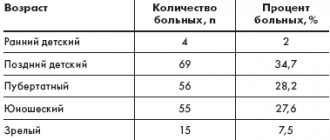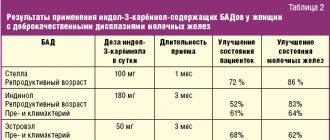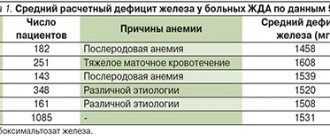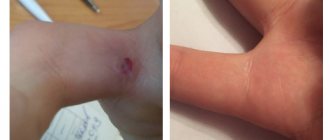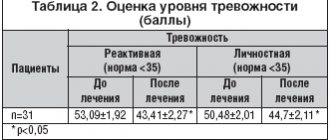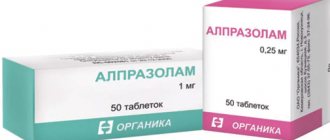Mode of application
Children from 2 to 5 years: for acute conditions - 1 tablet 3 times a day until the condition improves. During further treatment, continue to take 1 tablet 3 times a day.
Children from 6 to 11 years old: for acute conditions - 1 tablet every 2 hours (but not more than 6 tablets per day) until the condition improves. For further treatment, take 1 tablet 3 times a day.
Adults and children over 12 years of age: for acute conditions – 1 tablet hourly (but not more than 12 tablets per day) until the condition improves. For further treatment, take 1-2 tablets 3 times a day.
For chronic conditions, children and adults - 1 tablet 3 times a day, the recommended duration of treatment is 4-6 weeks.
It is not recommended to take Cinnabsin for more than 4 weeks without consulting a doctor.
Cinnabsin tablets No. 20x5
Name
Cinnabsin tablet in pack No. 20x5
Description
Tablets are white or almost white, flat, with a beveled edge, possibly containing inclusions of a darker color.
Release form
lozenges
Dosage
100 pieces
Directions for use and doses
Unless otherwise prescribed by a doctor, Cinnabsin is taken as follows: adults and children over 12 years of age in acute cases of the disease take 1 tablet every hour (but not more than 6 tablets per day) for the first two days. For subsequent treatment or for chronic disease, adults and children over 12 years of age take 1 tablet 1-3 times a day. When the severity of symptoms decreases, the frequency of dosing should be reduced. Tablets should be taken half an hour before meals or half an hour after meals. Children from 6 to 12 years old are prescribed half the adult dose. For this purpose, one tablet is dissolved in 6 teaspoons of water before use. A single dose corresponds to 3 teaspoons of the prepared solution, taken half an hour before or after meals. The remaining part of the solution is not subject to further use and must be destroyed. In acute cases of the disease, the solution (3 teaspoons) is taken every hour (but no more than 6 times a day) for the first two days. For subsequent treatment or for chronic disease, the solution (3 teaspoons) is taken 1-3 times a day. When the severity of symptoms decreases, the frequency of dosing should be reduced. Cinnabsin should not be taken for more than 4 weeks without consulting a doctor. The duration of use of the drug is determined by the doctor.
Use during pregnancy and lactation
Due to the lack of sufficient data, taking the drug Cinnabsin during pregnancy or lactating women is possible only after consulting a doctor if the expected benefit to the mother outweighs the possible risk to the fetus or breastfed child.
Precautionary measures
Homeopathic medicine. Consult your physician before use. If swelling of the face develops, fever, severe headache, new symptoms appear, and also if during the first 2 days of treatment your condition does not improve or worsens, you should consult a doctor. The use of Cinnabsin is not recommended for:
- progressive systemic diseases (such as tuberculosis, sarcoidosis)
- systemic diseases of the leukocyte system (for example, leukemia or leukemia)
- autoimmune diseases (for example, systemic connective tissue diseases (collagenoses), multiple sclerosis)
- immunodeficiency (AIDS, HIV infection)
- immunosuppression (for example, after organ or bone transplantation)
After taking Echinacea preparations, reports have been received of the development of allergic reactions (skin rashes, itching, in rare cases - swelling of the face, shortness of breath, dizziness, decreased blood pressure). Echinacea may cause allergic reactions in patients with atopic diseases (eg, atopic dermatitis, asthma, hay fever). Therefore, patients with atopic diseases should consult a doctor before taking Cinnabsin. Taking medications containing echinacea has in rare cases been associated with the occurrence of autoimmune diseases. Isolated cases have been reported in which long-term use of the drug (more than 8 weeks) led to a decrease in the number of leukocytes. Cinnabsin should not be prescribed to patients with galactose intolerance, lactase deficiency or glucose-galactose malabsorption. Wheat starch may contain traces of gluten, so caution should be used when treating patients with celiac disease. The effect of a homeopathic remedy may decrease when smoking or under the influence of other bad habits (for example, drinking alcohol).
Interaction with other drugs
No interaction information available. In case of simultaneous use of other drugs, you should consult your doctor.
Contraindications
Cinnabsin is contraindicated in patients with hypersensitivity to one of the active substances, to other plants of the Asteraceae/Compositae family, or to other components included in the drug. Cinnabsin is contraindicated in children under 6 years of age.
Compound
tablet contains: active substances: Cinnabaris trit. D3 25 mg, Hydrastis trit. D3 25 mg, Kalium bichromicum trit. D3 25 mg, Echinacea trit. D1 25 mg; excipients: lactose monohydrate, magnesium stearate, wheat starch.
Overdose
There is no information about cases of overdose.
Side effect
After taking Cinnabsin, hypersensitivity reactions, as well as nausea and vomiting, are possible. After taking Echinacea preparations, reports have been received of the development of allergic reactions (skin rashes, itching, facial swelling, shortness of breath, dizziness, decreased blood pressure, bronchospastic reactions, anaphylactic shock, Stevens-Johnson syndrome). Echinacea may cause allergic reactions in patients with atopic diseases (eg, atopic dermatitis, asthma, hay fever). Wheat starch may cause hypersensitivity reactions. Due to the content of mercury compound (Cinnabaris), increased salivation and the development of allergic reactions are possible. In these cases, you should stop using the drug and consult a doctor. When taking homeopathic medicines, a transient increase in existing symptoms of the disease (initial worsening) is possible; in this case, you should stop taking the drug and consult your doctor.
Storage conditions
Store in original packaging at a temperature of 15 °C to 25 °C out of the reach of children.
Side effects
In rare cases, hypersensitivity reactions may occur, including skin rash, gastrointestinal disturbances including nausea, vomiting and diarrhea. Patients who used other drugs containing Echinacea experienced allergic reactions (skin rash, itching, and in some cases facial swelling, dyspnea, dizziness and decreased blood pressure). Echinacea may cause allergic reactions in atopic patients (eg, patients with hay fever, neurodermatitis, allergic asthma).
Note!
Description of the drug Cinnabsin table. No. 60 on this page is a simplified author’s version of the apteka911 website, created on the basis of the instructions for use.
Before purchasing or using the drug, you should consult your doctor and read the manufacturer's original instructions (attached to each package of the drug). Information about the drug is provided for informational purposes only and should not be used as a guide to self-medication. Only a doctor can decide to prescribe the drug, as well as determine the dose and methods of its use.
Experience in the use of combination drugs in the treatment of rhinitis and sinusitis in children
The incidence of sinusitis is still quite high. According to various authors, diseases of the nose and paranasal sinuses affect from 17 to 22% of the child population. One of the significant factors in the pathogenesis of acute and especially chronic inflammatory diseases of the nose and paranasal sinuses is a violation of the mechanism of mucociliary transport. This is most often associated with swelling of the mucous membrane, excessive formation and increased viscosity of nasal secretions, which entails a disorder of drainage, respiratory, secretory and olfactory functions. The most common treatment for sinusitis is oral or intramuscular antibiotics. Since the supply of antibiotics from the bloodstream to the site of inflammation is limited, the treatment of sinusitis must be comprehensive.
First of all, this should concern improving ventilation, as well as drainage of the paranasal sinuses and nasopharynx.
Until now, otolaryngologists do not always practice prescribing adequate mucoregulating drugs included in the treatment regimen for patients with sinusitis, which, by thinning the thick viscous secretion and improving mucociliary clearance, help remove secretions from the sinuses. Among the drugs that affect mucociliary activity, previously used drugs that stimulate the liquefaction of rhinobronchial secretions, or so-called mucolytics, which change the viscosity of the secretion, affecting its physicochemical properties. We are talking about enzymes (trypsin, chymotrypsin, etc.), which are not currently used due to side effects.
Drugs that reduce surface tension also have a mucolytic effect, i.e., they act on the gel phase of the discharge and dilute both sputum and nasopharyngeal secretions. This group includes fluimucil (N-acetylcysteine), the action of which is associated with the ability of the free sulfhydryl group of N-acetylcysteine to cleave the intermolecular disulfide bonds of mucus glycoprotein aggregates, exerting a strong liquefying effect and reducing viscosity in relation to any type of secretion: purulent, mucopurulent, mucous . The peculiarity of fluimucil is that in addition to the direct mucolytic effect, N-acetylcysteine has powerful antioxidant properties and is able to protect the respiratory system from the cytotoxic effects of inflammatory metabolites, environmental factors, and tobacco smoke.
In the group of mucolytics, combination drugs are of great interest, namely rhinofluimucil, which, in addition to N-acetylcysteine, which dilutes the secretions, includes a sympathomimetic - tuaminoheptane sulfate, which has a mild vasoconstrictor effect and does not cause excessive dryness of the mucous membrane. After the disulfide bridges break, mucus and phlegm lose their viscosity, begin to absorb water and are gently removed when blowing the nose, sneezing, or coughing. Indications for the use of rinofluimucil are:
- prolonged purulent sinusitis with viscous thick secretion;
- chronic rhinitis with the formation of crusts in the nasal cavity and nasopharynx;
- vasomotor rhinitis with thick viscous discharge.
The effectiveness of the drug was assessed in a group of 55 patients aged 6 to 14 years; rinofluimucil was injected one dose into each half of the nose 3-4 times a day, the course was 6-7 days. The condition of the children was assessed by their subjective feelings before and after using the drug, as well as by objective criteria (reduction of hyperemia and congestion in the mucous membrane, improvement of nasal breathing, reduction of mucus, change in its rheological properties).
After 6-8 inhalations of rhinofluimucil, positive dynamics were noted.
The result of using the drug was assessed as follows: 70% of patients - excellent; 20% - good; 10% - satisfactory.
| Drawing. Comparative results of treatment with the antibiotic fluimucil IT and traditional methods |
There were no side effects from the use of the drug. The advantage of rhinofluimucil is that it acts on the surface of the mucous membrane and, by thinning the mucus, reduces its viscosity and promotes the productive physiological act of cleansing the nasal cavity.
The next drug that you should pay attention to is the fluimucil antibiotic IT, which combines two components in one dosage form: N-acetylcysteine and thiamphenicol glycinate (thiamphenicol is a drug from the chloramphenicol group). The spectrum of antimicrobial activity of the drug is presented in table. 1 (Clinical pharmacology of antibacterial drugs/Ed. Yu. B. Belousov, 1988).
The drug has a combined antibacterial and mucolytic effect and is recommended for the treatment of respiratory diseases caused by bacterial infection and accompanied by the formation of a thick viscous secretion. The antimicrobial activity of thiamphenicol is due to its interference with the synthesis of bacterial proteins. Recent studies have shown that the combination of thiamphenicol and N-acetylcysteine allows the drug to retain its unconjugated form and reach the site of inflammation in concentrations sufficient to create a bactericidal effect. The drug exhibits mucolytic activity against any type of secretion - mucous, mucopurulent, purulent. Fluimucil antibiotic IT facilitates the separation of sputum and nasal mucus. The drug is effective when administered into the paranasal sinuses.
We have data on treatment with the drug fluimucil-antibiotic IT in 37 children, of which 17 were diagnosed with acute sinusitis, 10 with exacerbation of chronic sinusitis and 10 with exacerbation of chronic purulent sinusitis. The control group of patients was treated using the traditional method without the use of fluimucil antibiotic. Comparative data is presented in the figure.
The drug was used for washing the paranasal sinuses after punctures or after surgery, including after endonasal opening of the ethmoidal labyrinth cells. Good results were obtained after 2-3 rinses: nasal breathing improved, swelling of the nasal mucosa decreased, the amount of secretion decreased, and its purulent nature disappeared. Indications and methods of use of the drug are presented in table. 2.
The effectiveness of the IT antibiotic fluimucil is determined not only by its antibacterial effect, but also by its ability to ensure rapid and complete removal of exudate, which in turn enhances the antibacterial effect.
Literature
- Ammosova S.P., Chuchalin A.G. et al. The effectiveness of N-acetylcysteine therapy in the treatment of liquidators of the Chernobyl accident with chronic bronchitis.
- Balyasinskaya G. L., Minasyan V. S., Kachkaeva E. D. The use of rinofluimucil in the treatment of rhinitis in children: Collection of works of the department. M., 2001. pp. 162-165.
- Garashchenko T. I., Bogomilsky M. R., Radtsig E. Yu. Mucoactive drugs in the treatment of non-purulent diseases of the middle ear: Collection of works of the department. M., 2001. pp. 157-162.
- Levin A. R., Zaitseva O. V., Vykhristyuk O. F., Kasyanov E. N. Results of the use of acetylcysteine in the complex treatment of children with bronchopulmonary diseases // Pediatrics. 1995. No. 5. P. 66-68.
- Sinopalnikov A.I., Klyachkina I.L. The place of mucolytic drugs in the complex therapy of respiratory diseases // Russian Medical Bulletin. No. 4. pp. 9-10.
- Samsygina G. A. et al. Experience in the use of acetylcysteine in the treatment of acute and chronic respiratory diseases in children // Pediatrics. 1995. No. 3. P. 76.
- Rizzata J. Aerosol antibiotics for the treatment of respiratory infections. The focus is on thiamphenicol glycinate acetylcysteinate. Publishing house "Mattioli", 1985, Therapist, 2001. No. 9. P. 1-6.
Note!
Fluimucil antibiotic IT has the following pharmacological and therapeutic properties:
- High bioavailability of the drug.
- High antibacterial activity, which is achieved thanks to a special dosage form.
- High mucolytic activity, ensuring the restoration of mucociliary clearance and the removal of pathological microorganisms.
- By creating a high therapeutic concentration of both an antibiotic and N-acetylcysteine in the affected organs.
